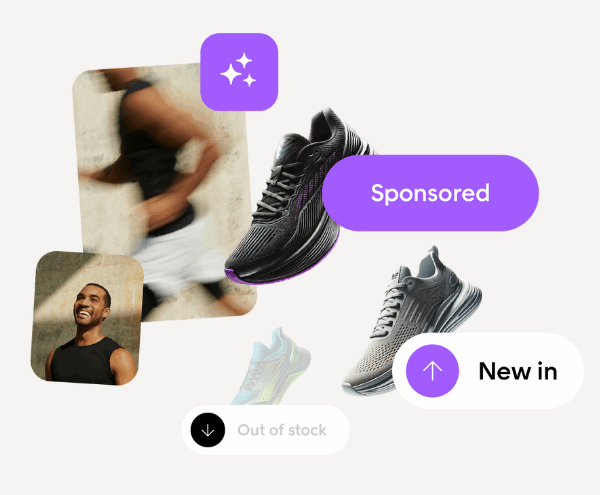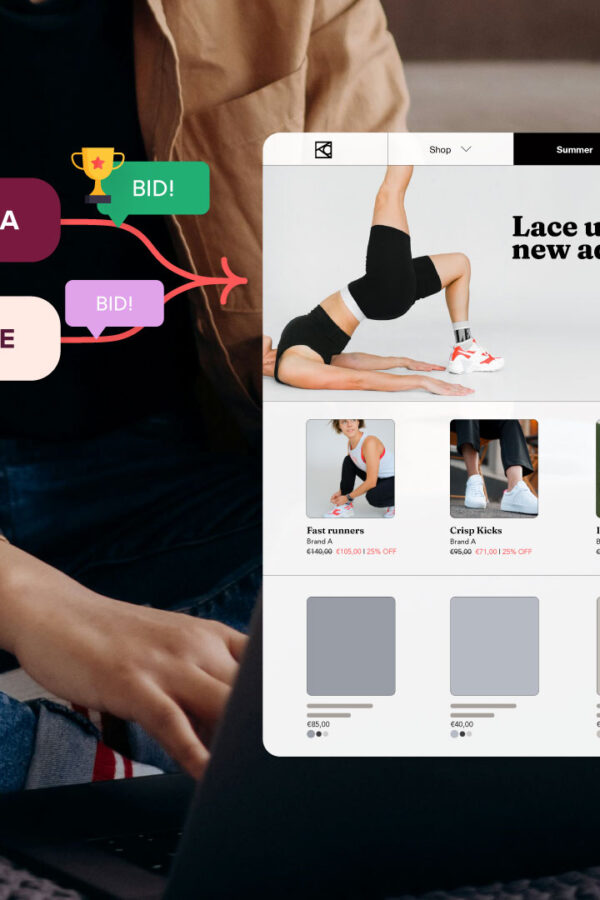TL;DR
- Multichannel retailing means meeting customers where they shop, across multiple sales channels.
- Success comes from connecting data, standardizing experiences, and staying consistent across every touchpoint.
- Use a coordinated, data-driven mix of online and offline channels to reach customers effectively.
- Measure what matters: engagement, repeat purchases, and channel performance.
- With Voyado, you can evolve from multichannel retailing to true omnichannel excellence faster.
A customer scrolls through your campaign while waiting for the bus. Later, they visit your store to see the product, then buy it online because delivery is easier. That’s what real shopping looks like today.
Fast, flexible, and driven by choice.
If your systems and teams don’t stay connected, customers feel it. Prices don’t match, loyalty points disappear, and trust starts to slip.
Multichannel retailing helps prevent that. It gives customers the freedom to shop wherever they want while keeping every touchpoint part of one brand.
Done right, it is the first step toward omnichannel retailing and a consistent customer experience that builds loyalty.
When you’re done reading, you’ll be able to:
- Define multichannel retailing and understand how it differs from omnichannel.
- Build a connected strategy that improves customer experience across every channel.
- Spot where your business stands today and what to do next to grow.
But what is multichannel retailing, and why do you need to care?
Multichannel retailing – A clear definition (and why it’s not omnichannel)
Multichannel retailing means selling and communicating with customers across multiple channels such as your online store, brick and mortar stores, social media, marketplaces, and email.
Each channel works independently, but together they reach a wider audience and create more ways for customers to buy.
Think of it as several teams working toward the same goal but not yet in sync.
That is where multichannel ends and omnichannel begins.
Multichannel vs. Omnichannel vs. Cross-channel
| Area | Multichannel | Cross-channel | Omnichannel |
| Data | Stored separately in each system | Shared between a few connected systems | Unified in one place for a single customer view |
| Messaging | Different messages per channel | Some coordination between key channels | Fully consistent and personalized across all |
| Inventory | Managed per store or site | Some visibility between channels | Real-time visibility across all locations |
| Attribution | Channel-level reporting | Partial tracking across touchpoints | End-to-end journey insights |
| Loyalty | Points and perks handled separately | Shared between a few platforms | One program recognized everywhere |
Where multichannel retailing shines
Multichannel retailing works best when you need to:
- Reach customers faster. Launch new sales channels like marketplaces or social media platforms without waiting for a full replatform.
- Build visibility. Grow awareness and reach new audiences across both online and offline channels.
- Learn what works. Gather customer data from multiple touchpoints to see which channels drive engagement and sales.
For growing retailers, it’s an easy, low-barrier step toward a more connected experience.
Where it starts to crack
As your retail channels expand, cracks begin to show:
- Data silos make it hard to get a single view of your customer.
- Inconsistent messaging across multiple platforms weakens your brand.
- Fragmented service frustrates customers when loyalty points or orders don’t sync between systems.
This is the point where many retailers realize they’ve outgrown their setup.
Now, you need to turn multichannel success into omnichannel engagement with a connected strategy that links every system and every customer interaction.
The multichannel portfolio canvas (choose channels that actually convert)
Your retail team is juggling more channels than ever before. So, the challenge isn’t choosing more; it’s knowing which ones deserve your time and budget.
The multichannel portfolio canvas helps you map and prioritize your mix so each channel plays a clear role in driving growth.
Start by grouping your channels into three layers that work together.
Core revenue channels
These are the foundation of your retail business.
They handle most transactions and create the base of your customer data.
- E-commerce site – Your digital storefront and data hub for online sales.
- Physical stores – The heart of your brand, building loyalty through personal experiences.
- Marketplaces – Quick routes to reach new customers and test product demand.
When these channels stay consistent on pricing, experience, and brand voice, they reinforce each other instead of competing.
Demand and engagement channels
These channels spark interest and bring customers back.
They help you attract new shoppers, nurture relationships, and guide buyers to your main revenue channels.
- Email, SMS, and RCS – Reliable, high-ROI tools for personalized communication.
- Paid social – Great for storytelling, discovery, and retargeting.
- Search – Captures ready-to-buy intent and high-converting traffic.
- Retail media – Places your brand in front of shoppers already exploring similar products.
Use these to build engagement loops that turn casual interest into repeat visits.
Enablement channels
These channels add convenience and connection. They often become the tie between online and in-store experiences.
- App – Keeps loyalty, offers, and personalization in one place.
- Clienteling tools – Help store associates deliver data-driven service that feels personal.
- Live shopping – Blends inspiration and conversion, creating interactive experiences that drive instant sales.
How to score your channels
Once your list is mapped, evaluate each channel with a quick scorecard. The goal is to know where to invest.
- Audience fit. Is your target audience active here?
- CAC or ROAS. Does it deliver profitable traffic?
- Operational effort. How complex is it to manage?
- Data capture. Can it improve your understanding of the customer?
- Attribution clarity. Can you track its influence on conversions?
- LTV impact. Does it grow long-term customer value?
The more clarity you have on each channel’s role, the easier it becomes to scale intentionally. That’s how a mix of platforms turns into a smart, connected multichannel retail strategy that drives both sales and loyalty.
The next step is to make sure every touchpoint feels connected. Let’s look at how to create consistent standards that make every channel feel like the same brand.
Experience standards: Make every channel feel like the same brand
Customers should never feel like they’re entering a different world when moving between channels.
Whether they browse your website, use your app, or visit a brick-and-mortar store, every touchpoint should deliver a seamless customer experience that builds trust.
In multichannel retailing, consistency makes multiple sales channels work together. Clear standards for design, service, loyalty, and content keep your brand unified and customers engaged from start to finish.
Brand and UX baselines
Customers trust brands that feel familiar, no matter which channel they shop in.
Your brand design and user experience set the tone across various channels, helping you maintain consistent branding and visual identity.
Keep navigation, product information, and pricing aligned across your e-commerce site, app, and stores.
When your look and tone remain the same across different sales channels, your business earns stronger recognition and long-term loyalty.
Service baselines
Customers judge your brand by the service they receive. Responsive customer service keeps the multichannel experience connected.
To strengthen service across every channel:
- Align delivery and return policies so expectations are clear
- Keep support hours and escalation paths consistent
- Match response times across channels to protect satisfaction
Unified service makes it easier to engage customers and build lasting relationships.
Loyalty baselines
A strong loyalty program supports the full customer journey. Customers should earn and redeem points online, in-store, or through your app.
Connecting loyalty data across channels improves retention and engagement. With CRM for retail, your teams can sync loyalty, purchase, and inventory data for a more personal, connected experience.
Content playbook
Your content is where brand consistency truly shows.
What you need to ensure that:
- Define your hero messaging, creative tone, and offer structures so your campaigns work across multiple channels.
- Make sure your visuals, calls to action, and promotional copy align with your overarching multichannel retail strategy.
- Encourage your marketing and merchandising teams to use the same structure and design logic for every campaign to maintain a unified story and increase customer satisfaction.
Here’s a checklist writers and merchandisers can use:
| ✅ | What to check | Why it matters |
| ☐ | Navigation and product details match across all channels | Prevents confusion and builds trust |
| ☐ | Pricing and promotions are consistent online and in-store | Avoids frustration and abandoned carts |
| ☐ | Delivery and returns info is identical everywhere | Reduces customer support load |
| ☐ | Loyalty points and rewards sync correctly | Keeps customers engaged and returning |
| ☐ | Headlines and visuals align with brand guidelines | Reinforces recognition and consistency |
| ☐ | Campaign copy and offers use approved tone and structure | Creates one clear brand voice |
Encourage your teams to use this checklist before launching any campaign or updating product content. It’s a small step that prevents costly inconsistencies and keeps your customer experience unified.
Data that de-silos multichannel (without a 12-month replatform)
Even the strongest multichannel retailing strategy can fall apart when data sits in silos.
Each team sees a different version of the truth, and customers start to feel it.
Prices vary, loyalty points disappear, and your service quality slips because no one can see what happened in other sales channels.
The good news is you don’t need to rebuild your tech stack to fix it.
Your business can start by connecting existing systems across multiple channels to improve visibility, personalization, and customer satisfaction.
According to Voyado’s retail radar, more than half of retailers now say that unifying data across different channels is their top priority for 2025.
Why? Because it’s the fastest path to a seamless customer experience.
Start with one customer ID
A unified customer identity is the foundation of every successful multichannel retail strategy. It lets your teams see the entire customer journey and engage customers more effectively across various platforms.
Key systems to connect:
- E-commerce platform
- POS system
- Email and SMS tools
- CRM and CDP
When every interaction flows into one profile, you can deliver the same message whether customers shop online, visit a store, or browse a social channel.
Voyado’s pro tip:
Centralize customer IDs early. It reduces confusion, improves service quality, and helps your business manage different sales channels more efficiently.
Standardize your key events
Your customers create thousands of data points as they move between multiple channels.
Standardizing those touchpoints helps your teams analyze what drives conversions and repeat purchases.
Core events to track:
- Product view
- Add to cart
- Purchase
- Return
- Store visit
- Loyalty earn or redeem
When these events use consistent naming and logic, your team can finally compare results between different channels and identify where to optimize.
Voyado’s pro tip:
Use consistent event names and timing rules across all tools. This keeps reporting clean, improves inventory management, and supports responsive customer service when issues arise.
Connect systems with minimal integrations
You don’t need a massive IT project to get your data working together. Focus on connecting only what has the biggest impact on customer satisfaction and business insight.
Minimum viable setup:
- E-commerce ↔ CRM
- POS ↔ CRM
- Email/SMS ↔ CRM
Once these systems are talking to each other, you’ll have a reliable source of truth for managing inventory, loyalty, and marketing data.
Voyado’s pro tip:
Tackle your integrations in phases. Start with customer data, then move to inventory management and order visibility. This approach reduces downtime and improves performance across various channels.
How Voyado helps unify your data
Data only drives results when it is connected and easy to use.
Voyado helps you turn scattered customer data into clear insight so your teams spend less time managing systems and more time improving experiences.
With retail marketing automation, your teams can:
- Turn customer insights into personalized communication across multiple sales channels
- Sync ecommerce, POS, and loyalty data automatically to reduce manual work
- Improve inventory management accuracy and response times for better service quality
This connected approach helps your teams engage customers better and meet rising expectations for speed, relevance, and consistency.
See how leading brands put this into practice by exploring omnichannel retailing.
When your data and systems work together, you can see the bigger picture.
The next step is to understand your current maturity level and what it takes to move from multichannel retailing to full omnichannel orchestration.
The “multi → omni” maturity ladder (assess where you are)
Every retailer is on the path from multichannel retailing to full omnichannel engagement. The goal is not to do everything at once but to understand where your business stands and focus on the steps that matter most.
This maturity ladder helps your team track progress across sales channels, data, and customer experience.
Level 1: Channel launch and basic analytics
You’ve launched multiple sales channels and started tracking performance, but your teams still work in silos. Reporting is channel-specific, and your customer journey feels disconnected.
Your quick win:
Connect your ecommerce and POS data first. It’s the fastest way to create visibility across channels and set the foundation for more personalized communication.
Level 2: Shared audiences and consistent offers
Your teams can now segment customers and share offers across different channels. Campaigns look more aligned, and customers start to recognize your brand wherever they shop.
What it looks like when you get this right:
Your store staff know which customers have active offers. Pricing and promotions match across multiple channels, and your brand feels unified and reliable.
Level 3: Cross-channel triggers
You’ve built triggers that connect browsing, store visits, and post-purchase experiences. For example, a customer who browses online might receive an email reminder, while an in-store purchase triggers a follow-up survey.
Watch out for:
Too many automated messages can backfire. Focus on meaningful triggers that improve customer satisfaction and build trust.
Level 4: Inventory visibility and flexible fulfillment
At this stage, your business is improving inventory management and fulfillment to meet customer expectations for convenience. Customers can buy online, pick up in store, or ship from any location.
Your KPI to track:
Delivery accuracy and speed. These metrics show how well your teams are managing inventory and how your service quality measures up across every channel.
Level 5: Real-time personalization and unified journey orchestration
You’ve reached full maturity. Data flows across all systems, giving every team, from marketing to retail ops, a complete view of the customer. Journeys are personalized, dynamic, and built around intent instead of channel.
What it looks like when you get this right:
Customers receive relevant offers at the right moment. Store teams can recognize shoppers instantly. Every touchpoint feels connected and effortless.
Self-assessment: find your level
Use this quick checklist to see where your business stands.
| Question | Yes / No | Why it matters |
| Do your teams manage more than one sales channel? | ☐ / ☐ | Shows how diversified your multichannel retailing setup is |
| Can you see customer activity across multiple channels? | ☐ / ☐ | Reveals whether your data is connected or siloed |
| Are your offers and pricing consistent across all platforms? | ☐ / ☐ | Consistency builds trust and customer satisfaction |
| Can you trigger messages based on browsing or store visits? | ☐ / ☐ | Indicates progress toward automation and engagement |
| Is your loyalty data unified across different systems? | ☐ / ☐ | Helps your business retain and engage customers effectively |
| Do you track and improve service quality using shared KPIs? | ☐ / ☐ | Shows how aligned your teams are on experience metrics |
| Is your inventory management connected across all locations? | ☐ / ☐ | Measures how well your systems support flexible fulfillment |
| Can your marketing and store teams use the same audience data? | ☐ / ☐ | Indicates collaboration and shared customer insight |
| Are you using automation to engage customers in real time? | ☐ / ☐ | Reflects your move toward responsive communication |
| Can you personalize journeys dynamically across every channel? | ☐ / ☐ | Defines whether you’ve reached true omnichannel maturity |
How to score it:
- 0–3 “yes” answers → Building your foundation (Levels 1–2)
- 4–7 “yes” answers → Connecting systems and people (Levels 3–4)
- 8–10 “yes” answers → Leading with data-driven orchestration (Level 5)
When your business understands its maturity level, it can invest in the right areas, set realistic goals, and track progress over time.
Next, we’ll explore practical playbooks that help your teams turn strategy into measurable results across all your sales channels.
Practical frameworks that drive results in multichannel retail
Now that your business knows where it stands, it’s time to act.
These practical frameworks help your teams turn strategy into connected customer experiences that drive sales, retention, and loyalty.
Each one can be adapted to your goals. Use them to connect touchpoints, trigger key moments, and create seamless shopping experiences across online and offline channels.
Product discovery and demand generation
Goal: Help customers find the right products faster.
How to do it:
- Improve search and recommendations in your online store.
- Extend reach through retail media, social media platforms, and online marketplaces.
- Run remarketing campaigns to re-engage target customers as they browse comparison shopping engines.
Trigger to test:
When a visitor browses a category but doesn’t add to cart, send a curated email or SMS with tailored recommendations.
Why it works:
It feels relevant, not pushy. Customers see products they care about, whether they’re online shopping or visiting your physical stores, while your team automates conversion opportunities quietly in the background.
Cart and checkout recovery
Goal: Win back abandoned carts and increase sales.
How to do it:
- Send a gentle reminder email.
- Follow with an SMS that builds urgency.
- Finish with a push message that builds trust and consistent branding across channels.
A/B test:
Compare reminders versus incentive messaging. For higher-value purchases, try personal outreach through clienteling.
KPI to track:
Cart recovery rate by channel. It reveals which marketing strategies bring customers back most effectively and boost sales opportunities across retail stores and online retail platforms.
Loyalty as a growth engine
Goal: Turn satisfied shoppers into repeat customers.
How to do it:
- Display points and rewards in emails, product pages, carts, and receipts.
- Automate reminders for expiring points or tier upgrades.
- Celebrate milestones to make customers feel valued.
With omnichannel engagement, your loyalty data syncs between ecommerce platforms, POS systems, and CRM tools, ensuring consistent branding and messaging across channels.
When it works:
Customers recognize their progress, trust your brand, and keep coming back because every interaction feels personal.
Store-connected experiences
Goal: Bridge the gap between online and offline channels.
How to do it:
- Automate Click & Collect updates, pickup alerts, and post-visit surveys.
- Let associates follow up on recent browsing or past purchases to raise brand awareness.
- Feed store and warehouse management system data into your CRM to track inventory and order flow accurately.
Quick win:
Give store staff access to customer data. They can offer responsive customer service that meets customer expectations and creates stronger relationships with your wider audience.
The bigger picture
When these frameworks align, your retail strategy becomes connected and consistent. Each step builds a clear brand experience that keeps shoppers engaged across all channels.
As your business grows, test new channels and refine what works. The goal is a smarter, data-driven approach that meets customer demands and drives lasting multichannel success.
Next, we’ll look at how to measure what matters most so your teams can scale what works.
Measurement that matters (from vanity to decisions)
Success in multichannel retailing is about knowing which metrics drive results.
The right measurements help your team make:
- confident decisions,
- refine marketing strategies,
- and deliver a consistent customer experience across every touchpoint.
Your data already exists across e-commerce platforms, CRM systems, and physical stores. The goal is to connect it so your team can see how customers shop, what increases sales, and where to focus next.
Acquisition: See where growth really starts
| Metrics to measure | Why it matters | Tip |
| CAC and ROAS by channel | Tracks acquisition cost and efficiency | Compare new and returning customers to understand profitability |
| Assisted conversions (from social media platforms, search, or online marketplaces) | Reveals which channels influence early interest | Combine data from online and offline channels for full visibility |
| New customer growth rate | Shows how your marketing strategies reach a wider audience | Use this insight to target customers with similar profiles |
Engagement: Track interest, not impressions
| Metrics to measure | Why it matters | Tip |
| Active email and SMS subscribers | Indicates audience health | Track how engagement changes after campaigns or promotions |
| Session depth on your online store | Measures content relevance and user experience | Spot which pages keep visitors exploring your online retail site |
| Repeat visit rate from social media channels or other platforms | Shows loyalty before purchase | Use this data to personalize outreach and meet customer expectations |
Commerce: Measure what converts
| Metrics to measure | Why it matters | Tip |
| Conversion rate (CVR) by entry channel | Identifies where customers shop and convert | Compare the CVR between online and in-store to see performance gaps |
| Average order value (AOV) | Tracks upsell and cross-sell effectiveness | Use it to refine promotions and product bundling |
| Return and refund rate | Highlights product or service quality issues | Combine this with sales data to prevent repeat issues |
| Sales data from retail stores, online marketplaces, and your ecommerce platform | Connects all revenue sources | Aligns marketing and managing inventory across different sales channels |
Loyalty and customer value: Spot what keeps people coming back
| Metrics to measure | Why it matters | Tip |
| 90-day repeat purchase rate | Shows how well your business retains customers | Segment by channel to see what builds the strongest relationships |
| CLV (customer lifetime value) by first channel | Helps prioritize investments | Focus spend on the channels that create repeat customers |
| Reward redemption and engagement rate | Measures loyalty activity and value | Track in both physical stores and online to maintain consistent branding |
Attribution: Connect results to the right effort
| Metrics to measure | Why it matters | Tip |
| Channel contribution to total revenue | Shows which sales channels create the most value | Identify new channels worth scaling |
| Cross-channel influence on conversions | Reveals how customers move between online and offline | Use insights to improve your retail strategy |
| Assisted revenue by campaign | Helps allocate marketing spend effectively | Compare last-click and data-driven models for a complete picture |
Build a simple performance dashboard
| Dashboard section | Metrics | Update frequency |
| Acquisition | CAC, ROAS, assisted conversions | Weekly |
| Engagement | Active subscribers, session depth, repeat visits | Weekly |
| Commerce | CVR, AOV, return rate | Daily |
| Loyalty/Value | Repeat rate, CLV, redemption rate | Monthly |
| Attribution | Channel influence, assisted revenue | Monthly |
Our pro tip:
Build your dashboard in any BI platform or CRM for retail that connects ecommerce, POS, and marketing systems.
When your data lives in one view, every team can act faster and improve service quality where it matters most.
Tracking your business performance across all channels gives you the clarity to act strategically instead of reactively.
Clear metrics turn effort into progress and progress into long-term multichannel success.
5 Common multichannel pitfalls and how to fix them
Even a strong multichannel retail strategy can lose momentum when the basics aren’t aligned. Here are five common pitfalls and how your team can solve them fast.
Pitfall 1: Channel sprawl
Too many new channels can drain time and resources.
The fix: Run a quarterly “keep or kill” review to focus on the ones that deliver the most value.
Pitfall 2: Offer inconsistency
When customers see different prices or promotions across channels, it erodes trust.
The fix: Centralize your promotions calendar inside your CRM for retail. One source of truth keeps every campaign aligned across teams.
Pitfall 3: Data dead ends
Disconnected systems lead to incomplete reporting and poor decisions.
The fix: Use consistent event naming and taxonomy across platforms so your data stays clean and comparable everywhere.
Pitfall 4: Team silos
When departments chase separate metrics, collaboration breaks down.
The fix: Set shared KPIs such as conversion rate, repeat purchase rate, and CLV. One unified scorecard keeps everyone working toward the same results.
Pitfall 5: Privacy and consent drift
Consent data gets lost or duplicated across tools.
The fix: Keep one clean consent store. Voyado helps automate consent management and ensures compliance stays up to date.
For more insights on how retailers are tackling these challenges, explore retail challenges.
Next, we’ll look at quick real-world examples that show how leading retailers apply these fixes to deliver smoother multichannel experiences.
Creating consistent brand experiences across online and brick-and-mortar stores
How retailers create connected customer experiences across online and in-store
Every retail category faces unique challenges. But whether you sell fashion, beauty, or groceries, the goal is the same- build a connected experience that keeps customers engaged wherever they shop.
Here’s what winning multichannel flows can look like across different industries.
Fashion
If you’re a fashion retailer, success comes from building anticipation and keeping momentum once products launch.
Your winning flow:
- Build excitement through drops and waitlists.
- Follow up with SMS or push alerts when items go live.
- Mirror those campaigns across stores and social for a unified launch story.
What success looks like:
Customers feel part of the brand story, not just the sale. They engage early, buy faster, and stay loyal through consistent experiences online and in store.
Beauty
If you’re a beauty retailer, your power lies in personalization.
Your winning flow:
- Start with quizzes or samples to collect first-party data.
- Use that data to send personalized bundles or recommendations.
- Reward returning shoppers with loyalty tiers or exclusive perks.
What success looks like:
Every touchpoint feels tailored. Customers trust your advice and return for more, driving steady growth through emotional loyalty.
Home & Lifestyle
If you’re a home or lifestyle retailer, inspiration is everything.
Your winning flow:
- Use content and social channels to spark ideas and guide discovery.
- Offer virtual or in-store design consults to build confidence.
- Simplify the final step with flexible or financed checkout options.
What success looks like:
You help customers turn inspiration into action. They associate your brand with expertise and ease – not friction.
Grocery
If you’re a grocery retailer, convenience keeps you competitive.
Your winning flow:
- Send weekly offers to drive routine visits.
- Enable click-and-collect or fast local delivery.
- Use reorder prompts and AI-driven recommendations to simplify repeat shopping.
What success looks like:
Shoppers spend less time searching and more time buying. Your team sees higher repeat rates and a smoother flow between online and brick-and-mortar stores.
When you understand how different retail segments win, it’s easier to spot what connects them – data, timing, and consistent execution.
The right platform brings those pieces together so your business can move from managing separate channels to creating one seamless customer journey.
Let’s look at how Voyado makes that transition faster and simpler.
Where Voyado fits and why it shortens the multi to omni journey
Moving from multichannel to omnichannel does not have to mean tearing everything down and starting over. The right platform connects what you already have: your data, your loyalty program, and your communication channels, and helps them work together.
That is where Voyado comes in.
Voyado helps retailers bring everything together in one connected system.
With Voyado, your teams can:
- Unify customer profiles across ecommerce, stores, and loyalty systems
- Coordinate campaigns and messaging across every channel
- Centralize loyalty experiences and rewards for consistent engagement
- Access real-time insights that help teams react faster to customer behavior
Instead of juggling disconnected tools, your teams can focus on what matters most: creating moments that feel personal and consistent at every touchpoint.
By Malene Birger, used Voyado to strengthen emotional loyalty. By connecting data from e-commerce, stores, and loyalty systems, they grew full-price shoppers by 109 percent.
“Emotional loyalty is about creating a deeper connection with your customers, giving them experiences that feel personal and valuable.”
– Laufey Lúðvíksdóttir, CRM and Loyalty Specialist at By Malene Birger
That is what Voyado enables. It gives your business a complete view of the customer so every campaign, message, and store visit feels connected and intentional.
If you are ready to see what this looks like in practice, book a demo and discover how Voyado can help your business move from multi to omni faster.
FAQs
What is multichannel retailing?
It is a retail strategy where brands sell and interact with customers through several channels, such as an online store, app, or brick-and-mortar shop.
How is multichannel different from omnichannel?
Multichannel runs separate channels side by side. Omnichannel connects them so that data, offers, and experiences flow seamlessly between them. Learn more from the best omnichannel customer experience platforms.
What are the biggest advantages and risks of multichannel retailing?
Advantages: wider reach and more sales.
Risks: inconsistent branding and disconnected data.
What are examples of multichannel retailers?
Retailers that sell online, in stores, and through social media or marketplaces, while using the same loyalty and marketing systems.
Which KPIs should we track first?
Track repeat purchase rate, average order value, and customer lifetime value to see how well channels work together.









